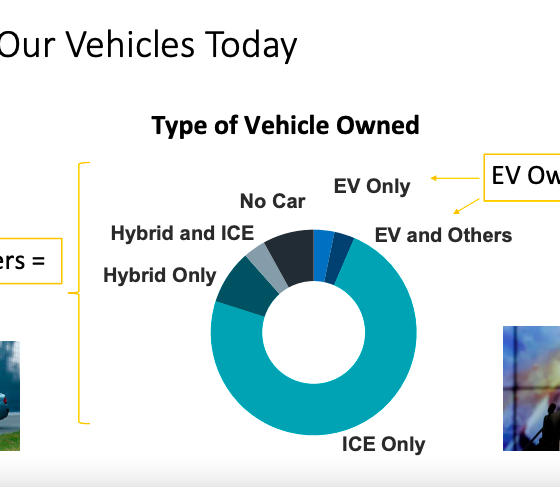A new study shows that only 26% of U.S. households are familiar with EVs but this is about to change. In the recent study by Parks Associates, it was noted that as Tesla became a household name, purchase intention for EVs has gone up 6%.
I wrote about this here, and Teslarati was invited to attend to the virtual session where Chris White, the senior analyst who conducted the study, led a virtual presentation.
According to the study,
“Only 26% of US broadband households report high familiarity with electric vehicles but that’s about to change. These sessions address the coming surge of EVs on the market, the potentially explosive EV growth in adoption, and the implications for consumers, the grid, and needed infrastructure.”
Electric Vehicles: A New Era for Consumers
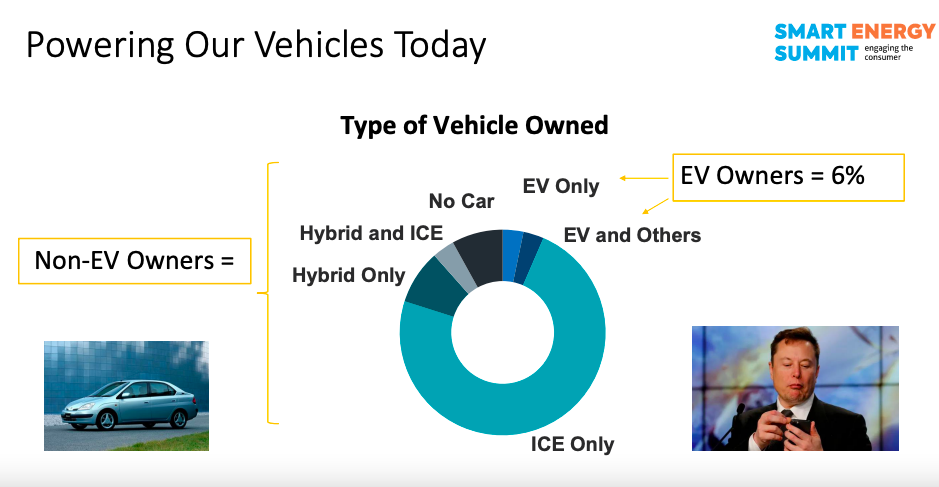
During the virtual session, Chris White explained some of the findings of the study. Some of these include current EV owner demographics, EV owner interest in clean energy, EV owners’ high-tech affinity, lack of knowledge of EV features, and how other issues such as the chip shortage are affecting both EV and non-EV markets.
The report was based on data from Q4 2021.
Understanding Current EV Owners
Current EV owners are young affluent and have dual incomes. Many are from a multifamily environment and use their EVs for work and school.
They use their vehicles regularly. It’s important to highlight since EVs have the image of a rare or exotic car that doesn’t have enough range. This is changing.
As the EV market continues to grow, the demographics of the current EV owners will most likely change. For now, there’s a 16% high intention of purchasing EVs among non-owners. Previous that was 10%.
That number didn’t include the current EV owners who either want to add a new EV or replace an old one.
EV Owners 3x likely to use renewable energy
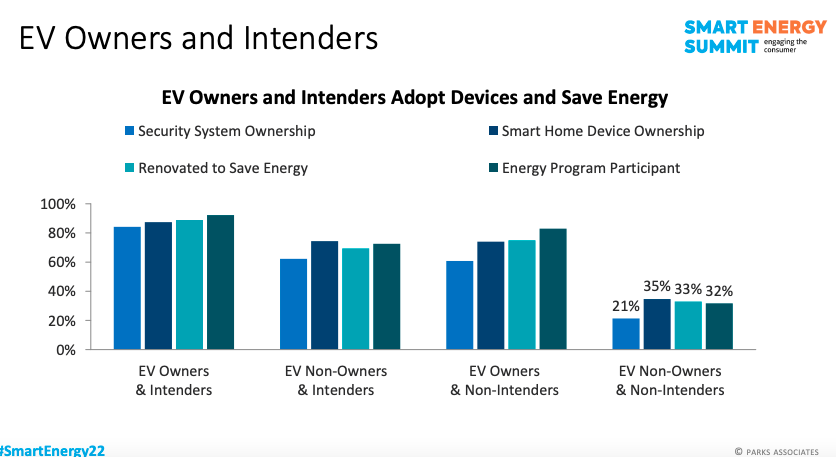
Chris White’s research showed that EV buyers are three times more likely to live in solar communities or have an interest in renewable energy powering their homes. They are also 2.5 to 5 times more willing to pay more for renewable energy.
The research shows that EV owners care about their carbon footprint and the impact on the environment.
EV owners are much more likely to own a security system or a smart home device than non-EV owners, according to the research
They xcare about technology and have a higher affinity for tech than non-EV owners.
Lack of familiarity with EV features.
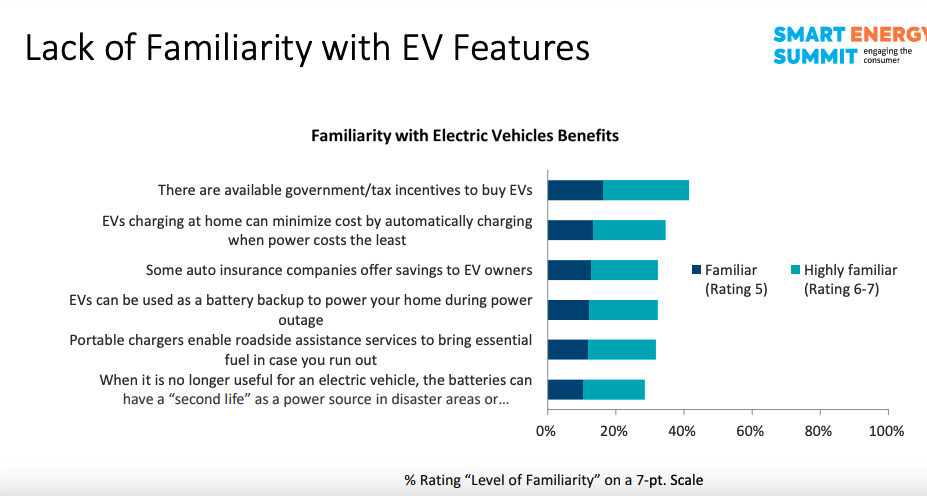
One of the key points in the study shows that although EVs are more popular today, there is a lack of familiarity with their features.
Chris pointed out that 18% of the consumers polled indicated familiarity with EV features. That isn’t a lot.
Features that many aren’t familiar with include EV charging at home minimizing cost when automatically charging during off-peak hours, auto insurance savings for EV owners, second-life EV batteries reused as a power source in disaster areas, and available tax incentives.
Second-life EV batteries are expected to reach over $34 billion by 2027 according to Research and Markets. You can read more about this here.
EV Features that could persuade non-owners to buy an EV
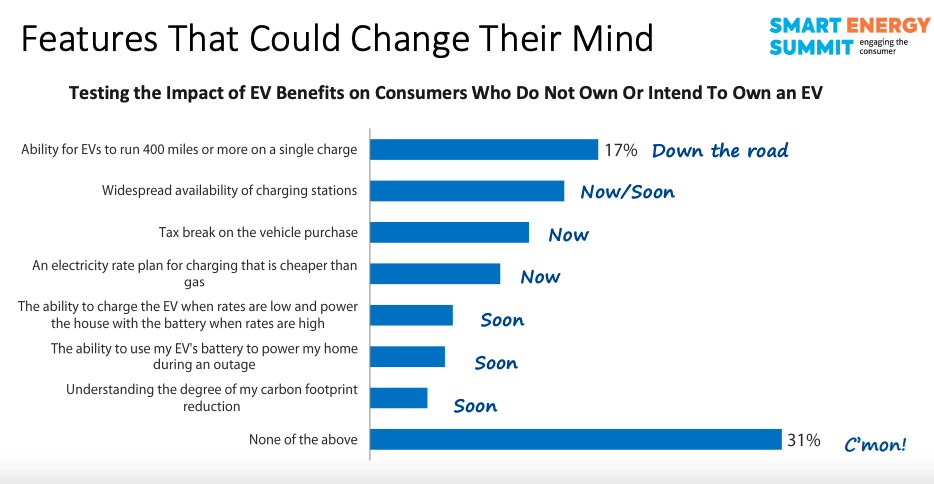
The study included the top features that could persuade non-EV owners to switch to electricity. The number one feature was for an EV to run 400 miles or longer on a single charge.
During the session, Chris pointed out that this is still rare and that most EVs are in the 200-300 mile range.
Other features included widespread charging stations and electricity plans that make owning an EV more affordable than owning an ICE vehicle. These are coming and soon people will see for themselves that EVs meet the criteria they are looking for.
Purchase Inhibitors.
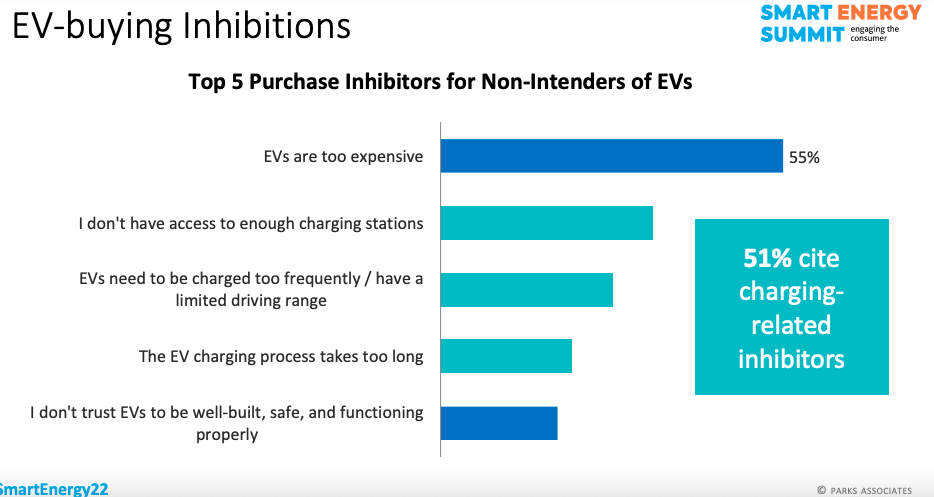
The number one purchase inhibitor that non-EV owners are concerned about are the cost of an EV and charging.
The research showed that 51% of the consumers who participated in the study cited charging-related issues.
Another issue was the lack of trust in the design of EVs,
Issues that impact both EV and non-EV purchases
We often see issues such as the semiconductor chip shortage and critical minerals for EV batteries impacting the EV market. However, something that impacts both markets includes the chip shortage, Putin invading Ukraine, and the national gas prices being on the rise.
The latter can create pain at the pump which is something that encourages people to make the switch to EVs. Last month, I wrote about Dobson who purchased a Tesla due to several factors but especially high gas prices.
EVs will be everywhere soon.
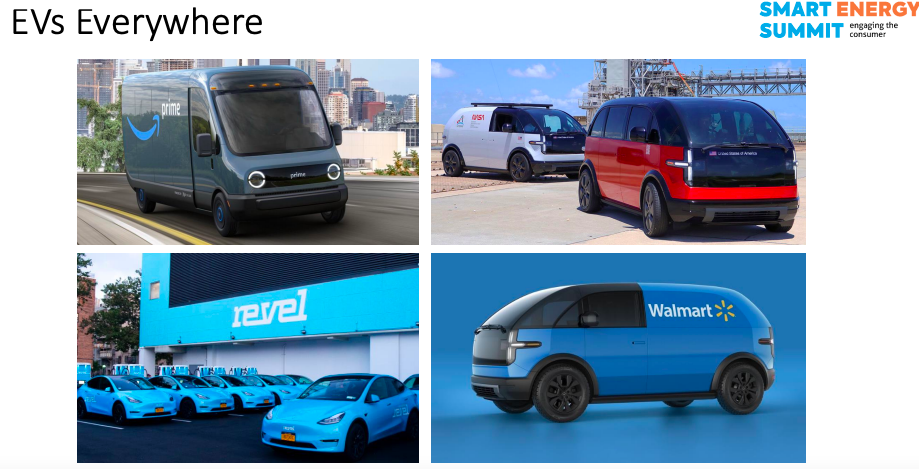
The research also revealed that soon, EVs will be everywhere.
Chris spoke about the Amazon and Rivian partnership, Walmart’s purchase of Canoo EVs, Revel’s fleet of Tesla taxis in New York, and the contract between NASA and Canoo.
And this is just on the commercial side. Other automakers are producing and marketing their own EVs to compete with Tesla.
Disclaimer: Johnna is long Tesla.
I’d love to hear from you! If you have any comments, concerns, or see a typo, you can email me at johnna@teslarati.com. You can also reach me on Twitter @JohnnaCrider1

Investor's Corner
Tesla price target boost from its biggest bear is 95% below its current level

Tesla stock (NASDAQ: TSLA) just got a price target boost from its biggest bear, Gordon Johnson of GLJ Research, who raised his expected trading level to one that is 95 percent lower than its current trading level.
Johnson pushed his Tesla price target from $19.05 to $25.28 on Wednesday, while maintaining the ‘Sell’ rating that has been present on the stock for a long time. GLJ has largely been recognized as the biggest skeptic of Elon Musk’s company, being particularly critical of the automotive side of things.
Tesla has routinely been called out by Johnson for negative delivery growth, what he calls “weakening demand,” and price cuts that have occurred in past years, all pointing to them as desperate measures to sell its cars.
Johnson has also said that Tesla is extremely overvalued and is too reliant on regulatory credits for profitability. Other analysts on the bullish side recognize Tesla as a company that is bigger than just its automotive side.
Many believe it is a leader in autonomous driving, like Dan Ives of Wedbush, who believes Tesla will have a widely successful 2026, especially if it can come through on its targets and schedules for Robotaxi and Cybercab.
Justifying the price target this week, Johnson said that the revised valuation is based on “reality rather than narrative.” Tesla has been noted by other analysts and financial experts as a stock that trades on narrative, something Johnson obviously disagrees with.
Dan Nathan, a notorious skeptic of the stock, turned bullish late last year, recognizing the company’s shares trade on “technicals and sentiment.” He said, “From a trading perspective, it looks very interesting.”
Tesla bear turns bullish for two reasons as stock continues boost
Johnson has remained very consistent with this sentiment regarding Tesla and his beliefs regarding its true valuation, and has never shied away from putting his true thoughts out there.
Tesla shares closed at $431.40 today, about 95 percent above where Johnson’s new price target lies.
News
I subscribed to Tesla Full Self-Driving after four free months: here’s why
It has been incredibly valuable to me, and that is what my main factor was in considering whether to subscribe or not. It has made driving much less stressful and much more enjoyable.

I have been lucky enough to experience Tesla Full Self-Driving for the entire duration of my ownership experience for free — for four months, I have not had to pay for what I feel is the best semi-autonomous driving suite on the market.
Today, my free trial finally ran out, and I had two choices: I could go without it for a period until I felt like I absolutely needed it, or I could subscribe to it, pay $99 per month, and continue to experience the future of passenger transportation.
I chose the latter, here’s why.
Tesla Full Self-Driving Takes the Stress Out of Driving
There are a handful of driving situations that I don’t really enjoy, and I think we all have certain situations that we would just rather not encounter. This is not to say that I won’t ever experience them as someone who has driven a car for 15 years (it feels weird saying that).
I don’t love to drive in cities; I really don’t like driving on I-695 on my way to Baltimore, and I truly hate parallel parking. All three things I can do and have done, all three within the past few weeks, too.
It takes all the stress out of city driving pic.twitter.com/q0SPPrH4HU
— TESLARATI (@Teslarati) December 4, 2025
However, if I can avoid them, I will, and Tesla Full Self-Driving does that for me.
Tesla Full Self-Driving Eliminates the Monotony
I drive to my alma mater, Penn State University, frequently in the Winter as I am a season ticket holder to Wrestling and have been for 16 years now.
The drive to State College is over two hours and over 100 miles in total, and the vast majority of it is boring as I travel on Rt 322, which is straight, and there is a lot of nature to look at on the way.
I am willing to let the car drive me on that ride, especially considering it is usually very low traffic, and the vast majority of it is spent on the highway.
The drive, along with several others, is simply a boring ride, where I’d much rather be looking out the windshield and windows at the mountains. I still pay attention, but having the car perform the turns and speed control makes the drive more enjoyable.
Tesla Full Self-Driving Makes Navigating Easier
Other than the local routes that I routinely travel and know like the back of my hand, I’ve really enjoyed Full Self-Driving’s ability to get me to places — specifically new ones — without me having to constantly check back at the Navigation.
Admittedly, I’ve had some qualms with the Nav, especially with some routing and the lack of ability to choose a specific route after starting a drive. For example, it takes a very interesting route to my local Supercharger, one that nobody local to my area would consider.
But there are many times I will go to a new palce and I’m not exactly sure where to go or how to get there. The Navigation, of course, helps with that. However, it is really a luxury to have my car do it for me.
To Conclude
There was no doubt in my mind that when my Full Self-Driving trial was up, I’d be subscribing. It was really a no-brainer. I am more than aware that Full Self-Driving is far from perfect, but it is, without any doubt, the best thing about my Tesla, to me.
It has been incredibly valuable to me, and that is what my main factor was in considering whether to subscribe or not. It has made driving much less stressful and much more enjoyable.
🚨 How I’ve gotten Tesla Full Self-Driving for free…until now
Watch me subscribe to Tesla FSD! https://t.co/bjK7EEOptR pic.twitter.com/cs5CmN5PdJ
— TESLARATI (@Teslarati) January 7, 2026
News
Tesla Diner becomes latest target of gloom and doom narrative

The Tesla Diner has been subject to many points of criticism since its launch in mid-2025, and skeptics and disbelievers claim the company’s latest novel concept is on its way down, but there’s a lot of evidence to state that is not the case.
The piece cites anecdotal evidence like empty parking lots, more staff than customers during a December visit, removed novelty items, like Optimus robot popcorn service and certain menu items, the departure of celebrity chef Eric Greenspan in November 2025, slow service, high prices, and a shift in recent Google/Yelp reviews toward disappointment.
The piece frames this as part of broader Tesla struggles, including sales figures and Elon Musk’s polarizing image, calling it a failed branding exercise rather than a sustainable restaurant.
This narrative is overstated and sensationalized, and is a good representation of coverage on Tesla by today’s media.
Novelty Fade is Normal, Not Failure
Any hyped launch, especially a unique Tesla-branded destination blending dining, Supercharging, and a drive-in theater, naturally sees initial crowds taper off after the “Instagram effect” wears down.
Tesla makes major change at Supercharger Diner amid epic demand
This is common for experiential spots in Los Angeles, especially pop-up attractions or celebrity-backed venues. The article admits early success with massive lines and social media buzz, but treats the return to normal operations as “dying down.”
In reality, this stabilization is a healthy sign of transitioning from hype-driven traffic to steady patronage.
Actual Performance Metrics Contradict “Ghost Town” Claims
- In Q4 2025, the Diner generated over $1 million in revenue, exceeding the average McDonald’s location
- It sold over 30,000 burgers and 83,000 fries in that quarter alone. These figures indicate a strong ongoing business, especially for a single-location prototype focused on enhancing Supercharger experiences rather than competing as a mass-market chain
It’s not a ghost town lol. The @Tesla Diner still had over 30,000 burger orders and 83,000 fries orders in Q4. The diner generated over $1M in revenue in Q4, a $4M annual run rate, which is more than the average McDonald’s…. pic.twitter.com/XvAGLUqxej
— Sawyer Merritt (@SawyerMerritt) January 4, 2026
Conflicting On-the-Ground Reports
While the article, and other similar pieces, describe a half-full parking lot and sparse customers during specific off-peak visits, other recent accounts push back:
- A January 2026 X post noted 50 of 80 Supercharger stalls were busy at 11 a.m., calling it “the busiest diner in Hollywood by close to an order of magnitude
TESLA DINER 🍔
Frantic!!!
Crazy busy. pic.twitter.com/wMbmr8SFFn
— Rich & Sharon (@HullTeslaModel3) January 4, 2026
- Reddit discussions around the same time describe it as not empty when locals drive by regularly, with some calling the empty narrative “disingenuous anti-Tesla slop.”
When we visited it last week it was packed. We had to wait to enter, get a table and go to the restroom. We were lucky to find a spot to charge.
— Rani G (@ranig) January 4, 2026
Bottom Line
The Tesla Diner, admittedly, is not the nonstop circus it was at launch–that was never sustainable or intended. But, it’s far from “dying” or an “empty pit stop.”
It functions as a successful prototype: boosting Supercharger usage, generating solid revenue, and serving as a branded amenity in the high-traffic EV market of Los Angeles.
